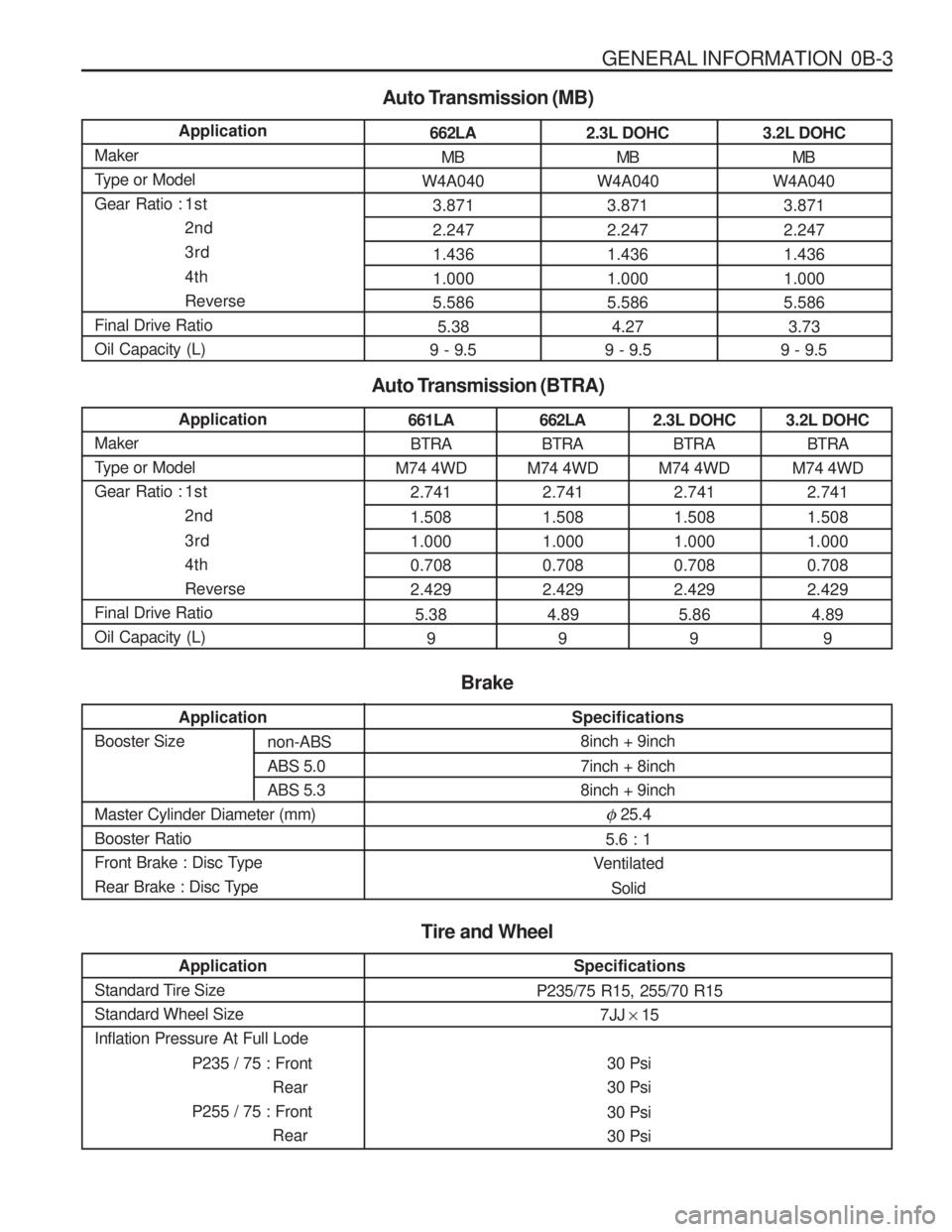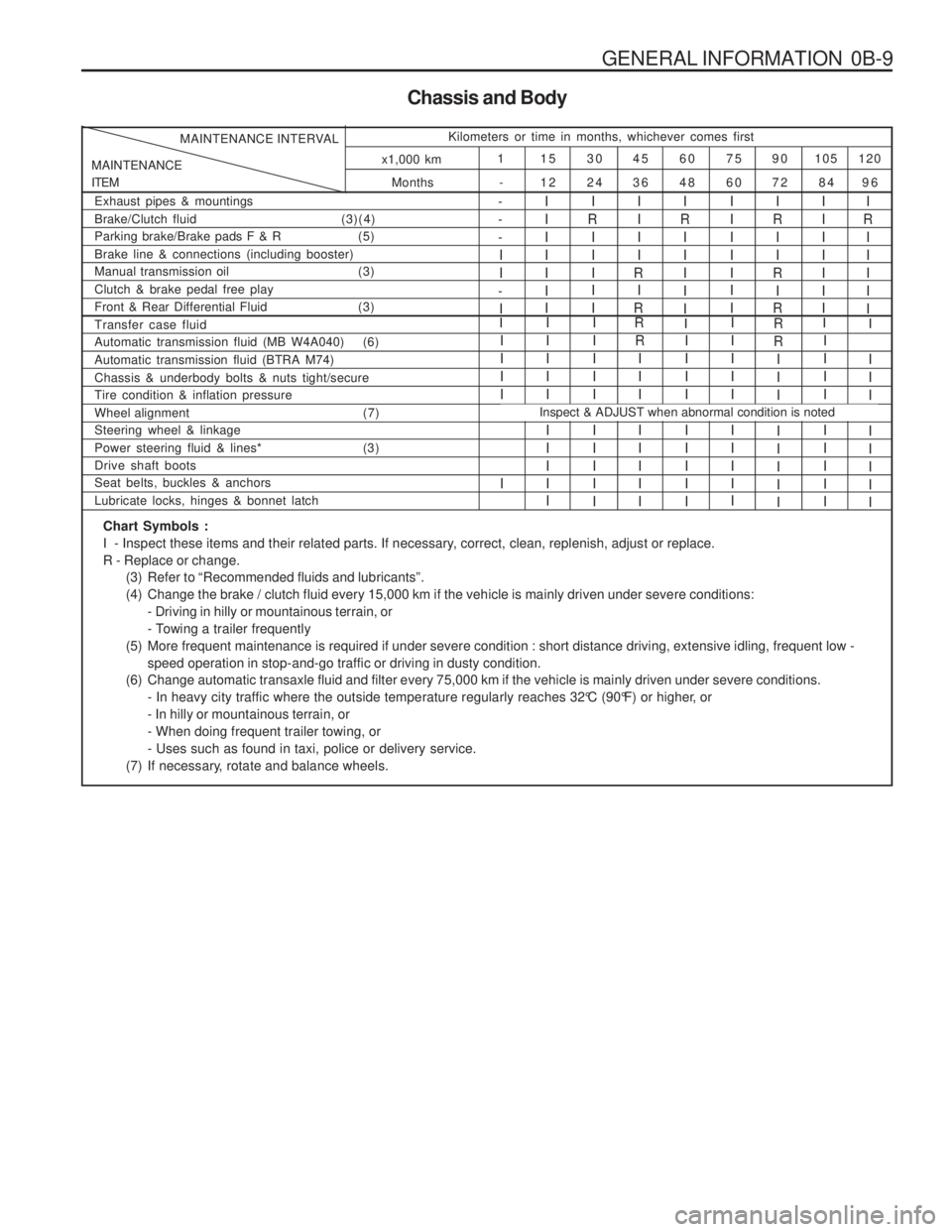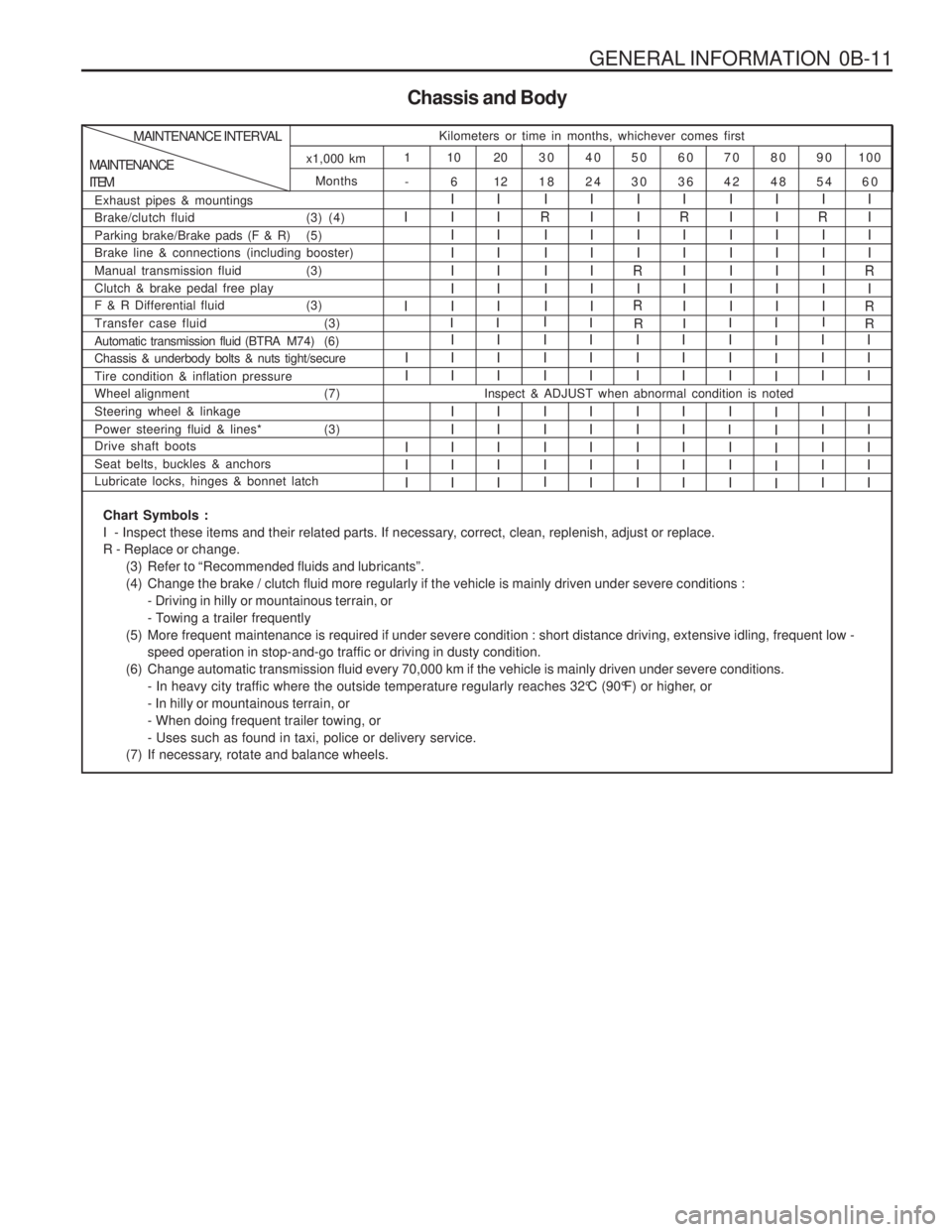inflation pressure SSANGYONG MUSSO 2003 Service Manual
[x] Cancel search | Manufacturer: SSANGYONG, Model Year: 2003, Model line: MUSSO, Model: SSANGYONG MUSSO 2003Pages: 1574, PDF Size: 26.41 MB
Page 3 of 1574

GENERAL INFORMATION 0B-3
662LA MB
W4A040 3.871 2.247 1.4361.0005.5865.38
9 - 9.5
Auto Transmission (MB)
Application
Maker
Type or Model
Gear Ratio : 1st 2nd3rd 4th Reverse
Final Drive RatioOil Capacity (L)
2.3L DOHC MB
W4A040 3.871 2.247 1.4361.0005.5864.27
9 - 9.5 3.2L DOHC
MB
W4A040 3.871 2.247 1.4361.0005.5863.73
9 - 9.5
661LA
BTRA
M74 4WD
2.741 1.508 1.0000.7082.429
5.38 9
Auto Transmission (BTRA)
Application
Maker
Type or Model
Gear Ratio : 1st 2nd 3rd 4thReverse
Final Drive RatioOil Capacity (L)662LA BTRA
M74 4WD
2.741 1.508 1.0000.7082.429
4.89 9 2.3L DOHC
BTRA
M74 4WD
2.741 1.508 1.0000.7082.429
5.86 9 3.2L DOHC
BTRA
M74 4WD
2.741 1.508 1.0000.7082.429
4.89 9
Tire and Wheel
Specifications
P235/75 R15, 255/70 R15 7JJ × 15
30 Psi 30 Psi 30 Psi 30 Psi
Application
Standard Tire SizeStandard Wheel SizeInflation Pressure At Full Lode
P235 / 75 : FrontRear
P255 / 75 : Front Rear
Application
Booster Size Master Cylinder Diameter (mm) Booster Ratio
Front Brake : Disc Type
Rear Brake : Disc Type
Specifications 8inch + 9inch 7inch + 8inch 8inch + 9inch
� 25.4
5.6 : 1
Ventilated
Solid
Brake
non-ABS ABS 5.0ABS 5.3
Page 9 of 1574

GENERAL INFORMATION 0B-9
Chassis and Body
Months
MAINTENANCE ITEM MAINTENANCE INTERVAL
Kilometers or time in months, whichever comes first
120
105
90
75
60
45
30
15
1
96
84
72
60
48
36
24
12
-
x1,000 km
Exhaust pipes & mountings Brake/Clutch fluid
(3)(4)
Parking brake/Brake pads F & R (5)Brake line & connections (including booster)
Manual transmission oil (3) Clutch & brake pedal free play
Front & Rear Differential Fluid (3)I
R
IIIII- --II
-
I IIIIII I
I
R I II I I IIII
R I
R IIIII I II
R
II
R I
R IIIIII II
R I IIII
Automatic transmission fluid (MB W4A040) (6) Automatic transmission fluid (BTRA M74)Chassis & underbody bolts & nuts tight/secure Tire condition & inflation pressure
Wheel alignment (7) Steering wheel & linkage
Power steering fluid & lines* (3)Drive shaft boots Seat belts, buckles & anchors Lubricate locks, hinges & bonnet latchIIII I I IIII I III I I IIII I IIII
R
III I IIII IIII I IIIIIIIII I III I
R R
III I IIII IIII I IIII
Transfer case fluidRII
I
Inspect & ADJUST when abnormal condition is noted
I
I II I IIII
Chart Symbols :
I - Inspect these items and their related parts. If necessary, correct, clean, replenish, adjust or replace.R - Replace or change.
(3) Refer to “Recommended fluids and lubricants”.
(4) Change the brake / clutch fluid every 15,000 km if the vehicle is mainly driven under severe conditions:- Driving in hilly or mountainous terrain, or
- Towing a trailer frequently
(5) More frequent maintenance is required if under severe condition : short distance driving, extensive idling, frequent low - speed operation in stop-and-go traffic or driving in dusty condition.
(6) Change automatic transaxle fluid and filter every 75,000 km if the vehicle is mainly driven under severe conditions. - In heavy city traffic where the outside temperature regularly reaches 32°C (90°F) or higher, or- In hilly or mountainous terrain, or- When doing frequent trailer towing, or- Uses such as found in taxi, police or delivery service.
(7) If necessary, rotate and balance wheels.
Page 11 of 1574

GENERAL INFORMATION 0B-11
Chassis and Body
Months -
MAINTENANCE ITEMMAINTENANCE INTERVAL
Kilometers or time in months, whichever comes first
100
90
80
70
60
50
40
30
20
10
1
60
54
48
42
36
30
24
18
12
6
x1,000 km
Exhaust pipes & mountings
Brake/clutch fluid (3) (4)
Parking brake/Brake pads (F & R) (5) Brake line & connections (including booster)
Manual transmission fluid (3)Clutch & brake pedal free play
F & R Differential fluid (3)
I I I IIIIIIIIIIIII I
R
IIIII IIIIIII IIII
R I
R I
R
IIIII IIIIIIIIIIIIII I
R
IIIII IIII
R I
R
Automatic transmission fluid (BTRA M74) (6) Chassis & underbody bolts & nuts tight/secure Tire condition & inflation pressure
Wheel alignment (7) Steering wheel & linkage
Power steering fluid & lines* (3) Drive shaft boots Seat belts, buckles & anchors Lubricate locks, hinges & bonnet latchI II I IIII III I IIII IIII I III I
I II I IIII III I IIIIIII I IIII III II II III I IIIIIII I IIII
Transfer case fluid (3)
RI R
I
I
I
I I I II IIII I IIII
Inspect & ADJUST when abnormal condition is noted
II I
Chart Symbols :
I - Inspect these items and their related parts. If necessary, correct, clean, replenish, adjust or replace.R - Replace or change.
(3) Refer to “Recommended fluids and lubricants”.
(4) Change the brake / clutch fluid more regularly if the vehicle is mainly driven under severe conditions :- Driving in hilly or mountainous terrain, or
- Towing a trailer frequently
(5) More frequent maintenance is required if under severe condition : short distance driving, extensive idling, frequent low - speed operation in stop-and-go traffic or driving in dusty condition.
(6) Change automatic transmission fluid every 70,000 km if the vehicle is mainly driven under severe conditions. - In heavy city traffic where the outside temperature regularly reaches 32°C (90°F) or higher, or- In hilly or mountainous terrain, or- When doing frequent trailer towing, or- Uses such as found in taxi, police or delivery service.
(7) If necessary, rotate and balance wheels.
Page 712 of 1574

2B-2 WHEEL ALIGNMENT
DIAGNOSIS
TIRE DIAGNOSIS Irregular and Premature Wear Irregular and premature tire wear has many causes. Some of them are incorrect inflation pressures, lack of regular rotation, poor driving habits, or improper wheelalignment. Rotate the tires if :
� The front tire wear is different from the rear.
� The left and right front tire wear is unequal.
� The left and right rear tire wear is unequal, Check wheel alignment if :
� The left and right front tire wear is unequal.
� The wear is uneven across the tread of either fronttire.
� The front tire treads are scuffed with “feather” edgeson the side of the tread ribs or blocks.
Tread Wear Indicators The original equipment tires have built-in tread wear indicators to show when the tires need replacement. These indicators appear as bands when the tire tread
depth becomes shallow. Tire replacement isrecommended when the indicators appear in three ormore grooves at six locations.
Radial Tire Waddle
Waddle is side-to-side movement at the front or rear of the vehicle. It is caused by the steel belt not being straightwithin the tire, or by excessive lateral runout of the tireor wheel. The vehicle must be road tested to determine which end of the vehicle has the faulty tire. The rear end of the vehicle will shake from side to side or “waddle” if the
waddle tire is on the rear of the vehicle. From the driver’ sseat, it feels as though someone is pushing on the sideof the vehicle. If the faulty tire is on the front of the vehicle, the waddle is more visual. The front sheet meld appears to be moving back and forth, and the drivers seat feelslike the pivot point in the vehicle.
Waddle can be diagnosed using the method of substituting known good tire and wheel assemblies onthe problem vehicle
1. Road test the vehicle to determine if the waddle is coming from the front or the rear of the vehicle.
2. Install good tires and wheels from a similar vehicle in place of those on the offending end of the problem vehicle. If the source of the waddle is not obvious, change the rear tires.